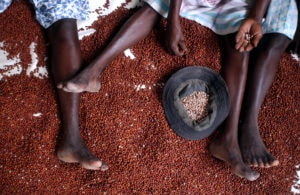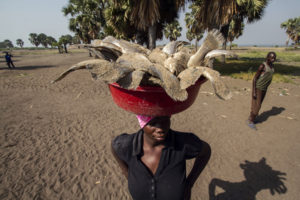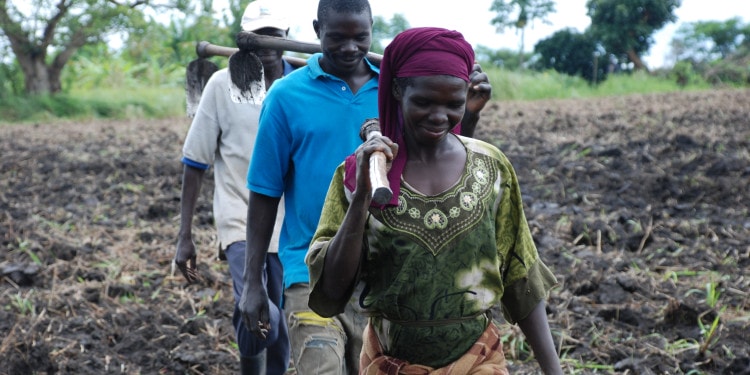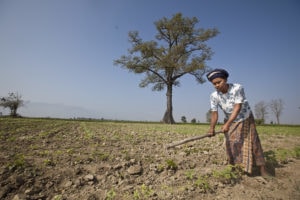Migration is as old as human existence. It involves movement of people between geographical locations within and between countries. It is part of the dynamic process of change in every society, with youth migration at its apex, and it has always been an important component of rural or structural transformation. As economies undergo a transformation, the movement of people in search of better employment opportunities and livelihoods within and between countries is inevitable.
Globally, rural-urban migration has accelerated in the last decades. Contrary to widely held perception, there is greater migration happening within a country than between countries, and within than between continents.
Developing countries hosted 13.9 million of the world’s total refugee population in 2015, compared to 2.2 million by developed countries. South-south or intra-continental migration, mainly between neighbors was 35.5 percent compared to less than 6 percent for south-north flows (FAO, 2016).
In particular, Africa has a rich history of population movements that pre-date the colonial period. About 15 percent of all international migrants in 2015 originated from Africa. However, 75 percent of the 33 million migrants in 2016 occurred within sub-Saharan Africa (Mercandalli and Losch, 2017). That is mainly attributed to the high rate of rural unemployment, lack of access to land, financial resources and services and decision-making.
Although migration is often being seen in a negative light in recent times, it can potentially create expanded opportunities for development for both the migration origin and migration destination (host), in terms of availability of new options, knowledge and expanded market opportunities.
The point is this: Both the destination and country of origin can benefit from migration. For instance, motivated migrants can contribute capacity, skills, technology, innovation and knowledge, and increase the development of the host country. Here, the potential of sustainable agriculture transformation in addressing migration is examined, especially as it relates to food insecurity, climate change and natural resources degradation as well as youth unemployment in sub-Saharan Africa.
IN THE PHOTO: Promoting aquaculture for food security and employment in Haiti. PHOTO CREDITS: FAO/Valerio Crespi
Main drivers of migration – including youth migration
The drivers of migration—the factors that trigger migration and cause people to move from one geographic location to another, and perpetuate people’s movement once the migration has started, have been a subject of intensive research in recent times.
Migration can be voluntary or involuntary, temporary, medium- to long-term, or even permanent, cyclic or seasonal. It may be triggered by choice, necessity, or a forced migration.
Economic migration is warranted by necessity, in search of better livelihoods and employment opportunities. Temporary migration is usually linked to employment, short crises and adaptation to climate or weather conditions. In general, people migrate due to the political economy, demographic shift, and environmental reasons and other socioeconomic considerations.
In extreme cases, forced migration may occur due to human-made crises, strife and conflicts, as well as due to natural disasters, environmental degradation and climate change.
Predicting future migration flows is difficult. It requires understanding the factors motivating different migration flows. The circumstances within which people make decisions to migrate or otherwise depends on the nature of the drivers or combination of them.
1. Political economy. One of the motivating factors for migration is the unfavourable macro-political economy. This is especially true of urban migration. Lack of good and responsive governance is one of the major element of this, but it also has to do with economy and inequities in national wealth distribution, unemployment and underemployment, lack of “voice” and support structures for starters. Other causes include economic change, crises or downturns making businesses not to flourish, political unrest, inflation, etc., creating wide structural disparities between the origin and the destination of migrants.
2. Forced migration. Human-induced crises and natural disasters compelling people to involuntarily move or flee is considered as forced migration, such as wars, violence, strife, armed conflicts, natural disasters, and or extreme famine that pose existential threats to life and livelihoods. This may affect both rural as well as urban dwellers. In recent times, Africa has been plagued with strife, conflicts and crises. These are sometimes compounded by climate change and other climatic shocks.

IN THE PHOTO: Revival of local bean seed production system in Haiti. The main objective is to improve food security of rural households in Haiti through revived and improved agricultural production. PHOTO CREDITS: FAO/Giuseppe Bizzarri
3. Demographic shift. One of the major causes for economic migration in Africa is the “youth bulge”—a situation where the population is skewed toward majority youth who are largely unemployed.
Rural out-migration can also exert a downward pressure on agricultural labor per capita, while migration of young people result in the loss of generational transfer of agricultural heritage and indigenous knowledge systems. Also, migration of predominantly males can also change the gender balance, leading to feminization of agriculture.
4. Socio-economic cause. Migration is inherent to the process of structural transformation and development. One of the major causes of social migration is the rural-urban gap—wide disparities in living standards of both rural and urban dwellers and access to livelihood needs.
Apart from rural migration, people can also move from urban areas to other cities or countries due to economic reasons, often linked to demographic shift and unemployment. In the past, poverty was considered as the main driver of migration. However, extremely poor people rarely have the resources to migrate far from their place of birth.
Rather than poverty, migration seems to be driven by a continued social transformation that has increased the capabilities and propensities of youth to migrate. Hence the large youth migration. This includes improvement in information and communication, even misperception of access to income opportunities.
5. Environmental degradation and natural disasters. Environmental degradation is a known trigger of migration and displacement, e.g. desertification, deforestation, erosion, flood, etc.
Climate change may pose major risks to rural people in developing countries and can lead to migration, depending on its scale, intensity and perceived threats. These include earthquakes, fires, floods, rising sea level, drought, extreme temperature rise or heat waves, etc. More people are displaced by extreme weather events than conflicts, and there is likelihood of increasing trend.
Natural resource degradation may affect the sustainability and productivity of food. This will in turn affect income and livelihoods opportunities of rural people. Efforts to bolster sustainable agriculture, including natural resource restoration is an essential part of an effective policy response to migration – with a direct impact on youth migration.
IN THE PHOTO: “Myanmar is considered one of the “most at risk” in the region for natural disasters. Building resilient livelihoods in order that they can withstand these threats is paramount and women’s role in this work cannot be overlooked. PHOTO CREDITS: FAO/Hkun Lat
The migration-agriculture nexus
There is a strong historical link between migration and agriculture (including include crop, livestock, forestry, fisheries and aquaculture).
Traditional shifting cultivation was motivated by a search for a more fertile land for cultivation; pastoralists migrate in search of water and pastures for livestock, and communities migrate to settle where the dwelling is safe and livelihood needs are better met. When such conditions were not adequate, people migrate to other places.
However, as population increases and natural resources become limited—especially land, and access to services, infrastructure, financial capital, decision-making (voice) and basic livelihood opportunities becomes more difficult, many youth, the landless and marginalised tend to migrate from rural areas.
It has now become evident that rural-urban migration is not the solution to reducing poverty. Byvelee et al (2009) had shown that migration from rural to urban areas accounted for less than 20 percent of the reduction in rural poverty during 1993-2002. The remaining 80 percent came from improvements in economic conditions in rural areas, including in agriculture.
This strongly suggests that efforts to sustainably transform agriculture and rural development can pay more dividends.
Some food- and agriculture-related levers to exert on migration challenge
There are eight levers that may be summarized as follows:
(i) Humanitarian and development response to forced migration and protracted crises. African countries host large flow of refugees, and countries such as Uganda, Kenya, Ethiopia and DR Congo, are among the top ten refugees-hosting countries in the world. These are generally forced migration and protracted crises that often involve loss of assets, destruction of infrastructure, farmlands, shelter and other production resources and market.
The immediate and most crucial response is essentially humanitarian in order to save lives, reduce shock and trauma, and to strengthen the resilience, stability and self-reliance for refugees as well as fostering social cohesion with the host communities. Such initial response typically focuses on basic needs, including basic shelter, nutritious food, water, medical care, and sometimes cases cash supply. These supports can be a matter of life and death at the onset of forced displacement trauma and shocks.
However, the majority of forced displacement incidents are characterized by protracted crises. Unfortunately, soon after the media publicity ebbs out, “donors fatigue” generally sets in as attention is mostly turned to new crises, while humanitarian support and attention to refugees wanes.
There is a need for appropriate exit strategies to ensure a sustainable livelihood for those in protracted situations.
(ii) Sustainable response to protracted crises situations. Most migration responses, especially for refugees, have mainly focused on “humanitarian” approach, mainly to save lives and reduce immediate shocks, alleviate suffering and enhance livelihood recovery. This early to medium-term humanitarian support is essential, and can be make the difference between life and death.
Ideally, refugees are expected to return back to their origin, but in many cases crises become protracted. A holistic development approach with long-term sustainable development solutions is therefore warranted.
While refugees are in host countries, they can contribute to the economy, if engaged productively. This is where natural resources rehabilitation, and sustainable agriculture and food systems can effectively contribute to reducing the pressure of migration on the host country.
This requires investing in capacity development, social protection, developing the infrastructure, re-schooling and training, and re-orienting migrants to build their resilience through creating sustainable, productive and profitable agricultural and off-farm jobs and career opportunities.
A strong focus on youth migrants is essential. Such long-term sustainable transformations must put people’s skills and preferences into consideration without locking them into unsustainable locations and conditions.

IN THE PHOTO: 04 February 2016, Butyaba, Buliisa District, Uganda – A woman carries a basin full of fish at Butyaba landing site on the shores of Lake Albert. PHOTO CREDITS: FAO/Isaac Kasamani.
The Government of Uganda (GoU) models one of the best refugee responses in the world (see Box).
The government and development community responded first with humanitarian support—providing food, cash and supplies to meet immediate needs. However, going forward it has also become necessary to shift from humanitarian to long-term development response, with a view to supporting refugees to be self-reliant while they remain in the host country.
| REFUGEES IN UGANDA: A MODEL TO FOLLOW In recent years, about 1.4 million refugees have crossed the border into Uganda, mainly from South Sudan, Somalia, Burundi and Congo DR, making Uganda the country with largest refugees and asylum seekers in Africa and second in the world. For instance, reoccurrence of violence coupled with severe drought in South Sudan has accelerated the rate of refugee influx to northern Uganda in 2017, now totaling over a million. The majority are youth migrants: A total of 61% of the refugees are under 18. Most are women (82%).
The Uganda Refugee Policy is very generous. Uganda’s 2017 Comprehensive Refugee Response Framework (CRRF) comprises of five pillars: 1) Admission and rights; 2) Emergency response; 3) Resilience and self-reliance; 4) Expand solutions, and 5) Voluntary repatriation. The GoU receives the refugees, registers them and transport them to settlement areas, rather than camps where they are provided with basic humanitarian support (Figure 1). It means refugees can move within the country without restrictions and settle among the communities, also with the right to seek employment. The government provides small land to each refugee family for both shelter and for farming. Beyond short term lifesaving intervention, a collective and coordinated approach, “Refugee and Host Population Empowerment” was launched in 2017 (see ReHoPE, 2017). |
(iii) Creating an incentive to attract youth to agriculture. One of the greatest untapped natural assets Africa has is its youth. This presents both opportunities and challenges.
Half of the population in sub-Saharan is under 25 years of age, and nearly 20 million people will enter the labour force in Africa every year, of which 12 million are from the rural areas. Youth unemployment is one of the major challenges in Africa, and it contributes to migration. Agriculture is Africa’s largest employer. It also offers the most immediate means of accelerating economic growth and create employment for young people (World Bank, 2014 a).
Youth are moving away from farming because they consider it unattractive, hazardous, labor-intensive characterized by a low return to labor. They lack capital, insurance, financial credit and are often not granted a voice in decision-making processes.
Young people can drive the desired change if appropriately empowered; they must be part of the solution. In order to realize this potential, agriculture has to shift from being seen as “poor people’s occupation” to a more dynamic, more profitable, less labour-intensive, better esteemed and recognized job and career opportunity for young people.
Making agriculture more attractive to youth can potentially reduce migration from rural areas. This requires a systemic transformation of the school curricular from training towards ‘white collar jobs’ to creating agribusinesses and decent employment opportunities along the value chain.
(iv) Catalyze the benefit of sustainable production intensification. Agriculture development is a pro-poor source of economic growth – about twice to four times more effective in raising incomes among the very poor than growth in other sectors (World Bank, 2014 b).
Rather than the usual palliatives, long-term investment efforts should be geared towards sustainable agricultural transformation that empowers the rural poor, especially the youth and women, as producers and agri-entrepreneurs, through building the infrastructure, capacity development, increasing access to markets, financial services and credits, to increase income, decent jobs and improve livelihoods.
This includes applying sustainable and productive, labour-saving and innovative practices and technological solutions, managing and conserving the natural resource capital and using inputs more efficiently. This also includes linking social protection to sustainable production and resilience building.
(v) Natural resources conservation, management and restoration. Depletion of sources of raw materials for certain businesses can translate to livelihood threat, thereby motivating migration to other parts where they are available.
A good example is the drying up over 30 years of Lake Chad that is now a food crisis hotspot. One way to address environmental migration is to ‘nip it in the bud’ by combating its root cause before it happens rather than post-factum interventions. Measures to address natural resource degradation and climate change may also help improve livelihoods and reduce migration.
With good governance, investment in land restoration in Africa has the potential to build the resilience of the people, farms, and ecosystems to reduce the impact of land degradation, desertification, loss of natural resources and biodiversity, create job opportunities and business along the value chain and enhance livelihoods.
For instance, Africa’s Great Green Wall initiative has the potential to restore 50 million ha of land, provide food security for 20 million people and create 350,000 jobs. This requires proper governance of natural resources and policies that ensure inclusiveness, social equity and access to services and market. Land tenure issues must also be addressed.
(vi) Transforming urban agriculture and food systems. The growing urbanization is becoming increasingly worrisome, with Africa being one of the fastest in the world. Migration is an important contributor to this urbanization trend, as people search for better social and economic opportunity, and away from environmental deterioration.
The link between migration and urbanization in Africa are rather complex, involving context-specific social processes and phenomena, with multiple, multi-directional and multi-dimensional linkages (Awumbilla, 2017). Public services in the urban areas will also be impacted and food requirement in the migration destination will increase. Therefore, transforming urban agriculture and the food systems can also help address reduce the pressure of migration.
vii) Governance and policies that strengthen and diversify agriculture-based livelihoods. African governments need long-term agricultural investment planning and holistic rather than short-term and sectoral approach. There is a need to scale up best practices that sustainably improve productivity, and reduce risks through diversification, social protection and long-term investment that integrate migration, build resilience/and adaptation to climate change.
There is need to integrate migration and climate change into national development and poverty reduction programmes, including disaster risk reduction and crisis planning and develop agricultural policies and practices that enhance resilience.
viii) Turn migration to win-win for host and sending countries. Migrants contribute to the labor force, labor market flexibility and contribute to the economy through taxes, livelihood expenses and social contributions. They also contribute to the skills and technological advancement.
Host countries can maximize the potential of migrants through productive engagement, education, capacity development and opportunities for integration in the society. Once people do not feel alienated they will participate in economic development and invest in host country.
There is need for better integration of migration in development policies of both host and sending (origin) countries. This includes improving remittance flows, and leveraging remittances for rural development, improving employment conditions and mechanisms, and facilitating international labor mobility through safe and legal channels (Dumont J.-C. and Liebig T. (2014). On the other hand, remittances from migrants can serve to boost the economy through private investment into agriculture, industry, real estate and other sectors.

FEATURED PHOTO: FAO Indigenous Peoples’s team shared its joint work with indigenous peoples in the celebration of their cultures and traditional food systems in Meghalaya, North East India. PHOTO CREDITS: FAO
Migration, and youth migration, are key to development
To conclude, migration is part of the process of development and rural transformation, resulting from a host of drivers, from natural disasters and climate change, to armed conflicts, to social or political economies.
Humanitarian and development response is vitally important for forced migration to address trauma, shocks and meet basic livelihoods, and to cope with protracted crises. However, efforts to address migration must not be detached from sustainable agricultural transformation to increase productivity and profitability.
Sustainable agricultural transformation is an approach that offers one of the most robust and immediate opportunities for addressing several of the drivers of migration in Africa. This can be achieved through improved efficiency of resource use, natural resources restoration and management, value chain development, transforming urban agriculture and food systems, and building resilience against climate change and market fluctuations.
All this can help create job opportunities for young people. Migrants can contribute to economic growth and improve food security and rural livelihoods of the host country or community. On the plus side, remittances from migrants can constitute an important source of (private) investment in the community of origin. This can go into agriculture or any other sectors of the economy e.g. real estate and entrepreneurship.
There is need for conducive and responsive policy that incentivizes diaspora remittances in as win-win manner. This includes efficient and fair remittance systems, improving employment conditions and facilitating labour mobility.
African cities can become engine of sustainable development that puts sustainable agriculture transformation as part of the solution to migration, urbanization and youth unemployment.
However, because of the rather complex and multidimensional drivers of migration, there is no single ‘one-size fits all’ and ‘silver bullet’ solution. Rather, it requires a holistic approach, underpinned by effective policies and responsive governance that create an enabling environment for sustainable transformation of the food and agriculture systems. This includes long-term investment in inclusive capacity development, building infrastructure, developing the value chain and creating market opportunities.















